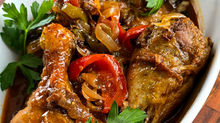The Djondjon Effect
- Alain Lemaire
- Jan 8, 2022
- 7 min read
What do you know about djondjon?
Are you Haitian? Do you know a Haitian? Have you had Haitian cuisine? Then, you definitely know the term "djondjon" and at some point have eaten the famous "riz djondjon" and even some other dishes that use it as a base such as "poulet djondjon", etc...

What is "djondjon"?
Literally mushrooms. It is a derivative of the French word champignons. It is a very distinctive variety of mushrooms that grows in Haiti. They are similar to oyster mushrooms and just as many other varieties, they grow in the wilderness, off of tree barks, in moist and dark areas. The "djondjon" farmers usually pick them during rainy seasons because that is when they are more affluent. Since mushrooms have a very short shelf life, and if not cared for properly can be toxic, the farmers let them dry under the sun. It is a pretty cool technique commonly practiced around the world when it comes to preserving and prolonging the shelf life of very sensitive food. Other example of sun dried food is sun dried tomatoes. Not only that the drying process helps with preservation, it also gives them added flavor.
"Djondjon" mushrooms are full of flavors, they pack an incredible, distinctive and unique aroma. You could even compare them to truffles. The other unique thing about these mushrooms is the color they give to dishes, which is black, something reminiscent of squid ink. The flavor, aroma and color of those mushrooms are what make them so amazing and enjoyable.
Where can you get djondjon?
Visit our supplier store Konbit Distribution and for a limited time, get 10% off your purchase using my code ChefLemaire
The Best Ways to Use Djondjon
How to use "djondjon"?
The process is quite simple but requires a few steps and a little patience. Your main goal is to extract the flavor and color out of the mushrooms. So you can, either:
- Grind it in a spice grinder to use in powdered form. No need to strain (my personal favorite).
- Boil it first for an hour or so, then drain it to use the liquid (the traditional technique).
- Boil first, blend it, then strain it to use the liquid.
- Blend first with liquid, then boil and strain it to use the liquid.
Traditionally, "djondjon" is used in a few select recipes like "riz djondjon" (rice) and "poulet djondjon" (stewed chicken with djondjon). But the are so many other applications thanks to its richness in flavor and color. At Sensory Delights, we use it in so many recipes, so please enjoy the following and share your success stories with us.
Fresh Djondjon Gnocchi
Ingredients:
- 2 lb. russet potatoes (about 4 medium), scrubbed
- 6-3/4 oz. (1-1/2 cups) djondjon powder, more for rolling
- 1 tsp. kosher salt
- 1 large egg, lightly beaten
Method of Preparation:
1. Put the unpeeled potatoes in a large pot. Fill the pot with enough cold water to cover the potatoes by at least 2 inches and bring to a simmer over medium-high heat. Reduce the heat to medium, partially cover the pot, and simmer the potatoes until they are completely tender and easily pierced with a skewer, 30 to 35 minutes.
2. Drain the potatoes, let them cool just enough that you can handle them, and then peel them. Cut them in half crosswise and pass them through a ricer into a large bowl. Let cool until almost at room temperature, at least 20 minutes.
3. Lightly flour a work surface. In a small bowl, mix the flour with the salt. Add the egg to the potatoes and then add the flour mixture. Mix with your hands until the flour is moistened and the dough starts to clump together; the dough will still be a bit crumbly at this point. Gather the dough together and press it against the bottom of the bowl until you have a uniform mass. Transfer it to the floured surface and wash your hands.
4. Knead gently until the flour is fully incorporated and the dough is soft, smooth, and a little sticky, 30 seconds to 1 minute. (Don’t overmix it, or the gnocchi will be tough; the dough should feel very delicate.) Move the dough to one side, making sure the surface underneath it is well floured. Cover it with a clean kitchen towel.
5. Cover two large rimmed baking sheets with parchment and sprinkle lightly with flour.
6. Remove any lingering bits of dough from your work surface and lightly re-flour the surface. Tear off a piece of dough about the size of a large lemon and put the towel back on the rest of the dough so it doesn’t dry out.
7. With the palms of both hands, roll the dough piece on the floured surface into a rope about 3/4 inch in diameter.
8. With a sharp knife or a bench knife, cut the rope crosswise every 3/4 inch to make roughly 3/4-inch-square gnocchi. Arrange the gnocchi in a single layer on the parchment-covered baking sheets, making sure they don’t touch. Repeat until you run out of dough, re-flouring the work surface as needed. When all the gnocchi have been cut and spread out on the baking sheets, sprinkle them with a little more flour.
9. If you’re going to use the gnocchi within 2 to 3 hours, they can sit out on the counter.
You can serve freshly made gnocchi right away or within a couple of hours, or you can freeze them for later use. Put the gnocchi in the freezer while they’re still on the baking sheets and freeze until they are hard to the touch, at least one hour. Transfer them to a large zip-top bag or several smaller bags and freeze for up to two months. Cook frozen gnocchi in boiling water in two batches. Frozen gnocchi cause the temperature of the cooking water to drop, so they’ll fall apart before the water returns to a boil if there are too many in the pot. Don’t refrigerate fresh gnocchi for more than two or three hours, as they tend to ooze water and become soggy.

Fresh Djondjon Pasta
Ingredients:
- 1 cup flour, plus extra for rolling the pasta
- 1 cup djondjon powder
- 1/2 teaspoon salt
- 3 large eggs
Method of preparation:
1. Combine the flour, powder and salt: whisk together the flour, powder and salt with a fork in a medium mixing bowl.
2. Add the eggs. Create a deep well in the middle of the flour and crack the eggs into this well. Whisk the eggs with the fork to combine.
3. Begin combining flour with eggs. As you whisk the eggs, begin gradually pulling in flour from the bottom and sides of the bowl. Don't rush this step. At first, the eggs will start to look like a slurry. Once enough flour has been added, it will start forming a very soft dough. Don't worry if you haven't used all the flour.
4. Knead the pasta dough. Turn the dough and any excess flour out onto a clean counter. Begin gently folding the dough on itself, flattening, and folding again. It will be extremely soft at first, then gradually start to firm up. Once it's firm enough to knead, begin kneading the dough. Incorporate more flour as needed to prevent the dough from sticking to you or the counter. Slice into the dough with a paring knife; if you see lots of air bubbles, keep kneading. The dough is kneaded when it forms a smooth elastic ball and has very few air bubbles when cut.
5. Rest the pasta dough. Clean and dry the mixing bowl. Place the ball of dough inside and cover with a dinner plate or plastic wrap. Rest for at least 30 minutes.
6. Divide the pasta dough. Sprinkle a baking sheet generously with flour and scrape the ball of dough on top (it will stick to the bowl; use a spatula or bowl scraper if necessary). Divide the dough into four equal portions. Dust the portions with flour and cover with a clean dishtowel.
7. Begin rolling the pasta dough. Set your pasta machine to the thickest setting (usually marked "1"). Flatten one piece of dough into a thick disk between your hands and feed it through the pasta roller. Repeat once or twice. Fold this piece of dough into thirds, like folding a letter, and press it between your hands again. With the pasta machine still on the widest setting, feed the pasta crosswise between the rollers (see picture). Feed it through once or twice more until smooth. If desired, repeat this folding step. This helps to strengthen the gluten in the flour, giving it a chewier texture when cooked.
8. Thin the pasta dough. Begin changing the settings on your roller to roll the pasta thinner and thinner. Roll the pasta two or three times at each setting, and don't skip settings (the pasta tends to snag and warp if you do). If the pasta gets too long to be manageable, lay it on a cutting board and slice it in half. Roll the pasta as thin as you like to go.
9. Cut the long stretch of dough into noodle-length sheets, usually about 12-inches. If making filled pasta or lasagna, proceed with shaping. If cutting into noodles, switch from the pasta roller to the noodle cutter, and run the sheet of pasta through the cutter. Toss the noodles with a little flour to keep them from sticking and gather them into a loose basket. Set this basket on the floured baking sheet and cover with a towel while you finish rolling and cutting the rest of the dough.
10. Cooking, drying or freezing the pasta. To cook the pasta immediately, bring a large pot of water to a boil, salt the water, and cook the pasta until al dente, 4-5 minutes. To dry, lay the pasta over a clothes drying rack, coat hangers, or the back of a chair, and let air dry until completely brittle. Store in an airtight container for several weeks. To freeze, either freeze flat in long noodles or in the basket-shape on a baking sheet until completely frozen. Gather into an airtight container and freeze for up to three months. Dried and frozen noodles may need an extra minute or two to cook.



.png)



























Love this! Thanks for sharing chef!